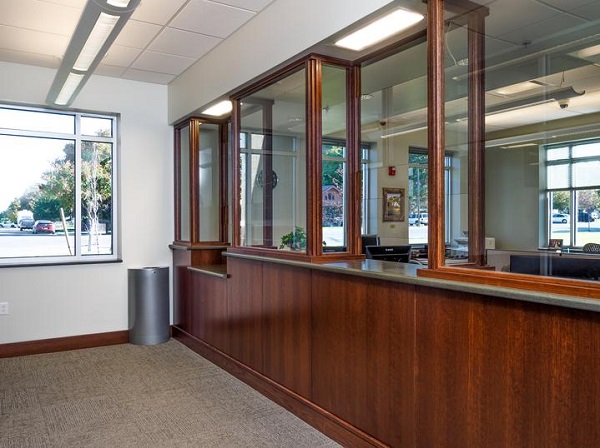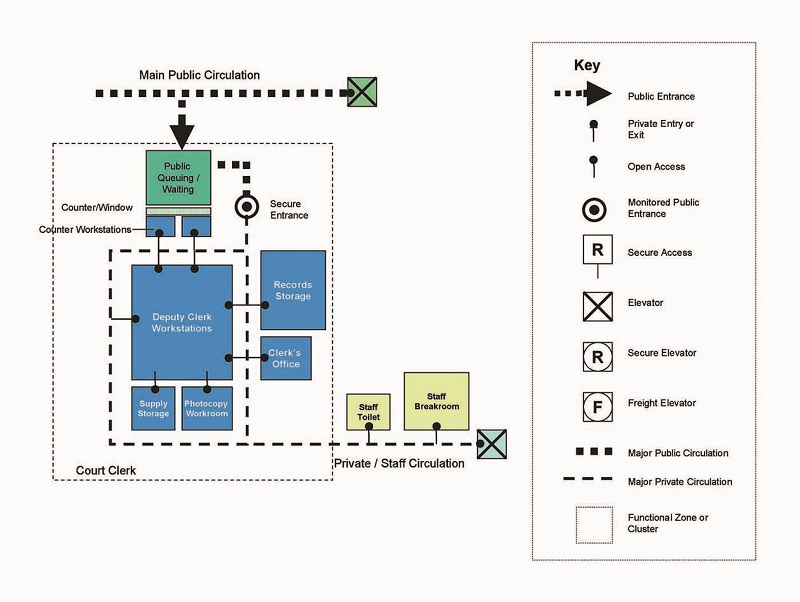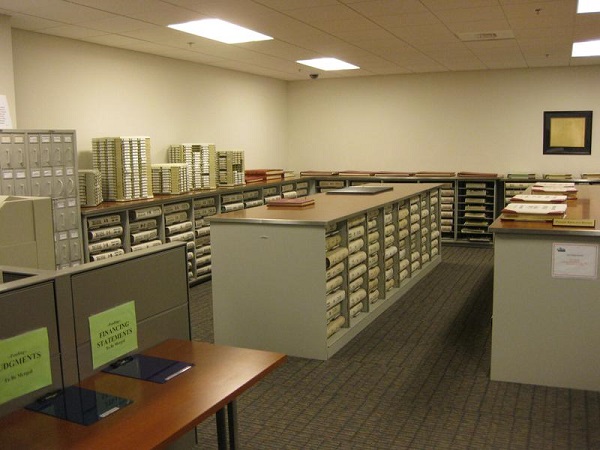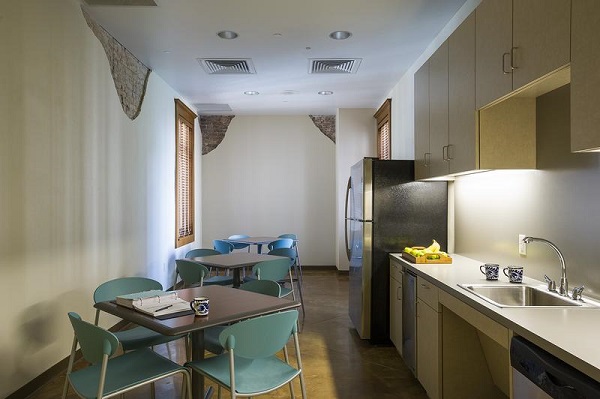 |
|
Juab County, Utah Courthouse Clerk Windows |
The clerk of court may be either elected or appointed. The clerk's office performs a variety of functions that may vary from jurisdiction to jurisdiction, especially in those that have a separate court administrator. Generally, however, there are six basic areas of responsibility:
- Care and custody of court records. The clerk's office is generally responsible for the safety and security of all court records, documents, case files and other pleadings filed in the office and for the storage and security of exhibits admitted into evidence.
- Calendaring and Scheduling of Cases. Most clerk's offices are responsible for preparing court calendars, scheduling bench and jury trials, monitoring case progress, and keeping minutes of courtroom activity.
- Jury selection and management. In some jurisdictions, the Clerk’s office is responsible for assembling a qualified pool of jurors, subject to empanelment, and assisting the court with voir dire.
- Judicial Functions. In some states the Clerk may be an ex-officio judge with jurisdiction over the probate of wills and administration of decedents’ estates. The clerk also may have jurisdiction to hear and decide special proceedings; including adoptions, condemnations of private property according to imminent domain, foreclosures, and procedures to administer estates of minors and incompetent adults. The clerk can be empowered to issue subpoenas and orders to show cause, administer oaths, issue arrest warrants, conduct initial appearances and fix conditions of release in non-capital cases, and accept waivers of appearance and pleas of guilty for certain misdemeanors and infractions. In some courts, the clerk may process small estates, handle small claims cases, and issue commitment orders. Some or all of these function may also be performed by a court administrator or jury commissioner.
- Statistical reporting. The clerk's office is generally responsible for producing and distributing such information.
- Accounting and administrative functions.The clerk is generally responsible for the collecting fees, fines, and support payments related to court activity, as well as for paying jurors. The clerk is also responsible for managing and supervising non-judicial staff, budgeting, and purchasing.
 |
Public Queuing and Waiting Area
There should be a public waiting area adjacent to the counter where the public waits to transact business. The size will depend upon the number of persons expected at peak periods. Generally, between 12 and 15 square feet per person should be allowed. The minimum distance from the entrance to the counter should be 10 to 12 feet in order to accommodate people waiting. The waiting area can be located off the main corridor in a separate enclosed area or part of the public corridors.
There should be signs and instructional material for the hearing impaired. Provision might be made for video display terminals with information for persons representing themselves in court. The waiting area may be furnished with chairs or benches. It may also include writing tables or wall-mounted counters for the public to complete forms. Computer terminals and video display monitors may be provided for viewing case status information and instructions regarding the filing of cases.
Public Transaction Counter
Every clerk's office should have a public counter where the public may transact business. The counter should be highly visible and large enough to accommodate anticipated needs. At least one section of the counter should be lowered to serve the needs of handicapped public and staff.
Public Counter Workstations
Counter staff workstations may be temporary work area or full-time work stations. The temporary stations work best when public contact is sporadic and deputy clerks have additional duties they perform at their desks. Full-time work stations function best when traffic flow is constant and in larger operations in which clerks are specifically assigned full-time to counter duty. The full-time work station allows the clerk to be seated on one side of the counter, while customers stand on the opposite side. The counter stations should be designed so that the staff and customer are at approximately the same eye level. This may require that the staff side of the counter be raised one or two risers.
The counter work station should be a standard workstation, complete with a computer, video monitor, printer, document scanner, receipt printer, and storage areas. In both temporary and permanent station arrangements the layout of the clerk's office should permit other clerks in the office to observe the counter and provide assistance.
Active files and records should be within easy access to the counter work stations. Counters should be wired to support computer and video display monitors. Security glazing or shatter-proof glass may be installed between the counter and the ceiling to reduce noise in the office and provide greater security.
Many clerk's offices perform duties that are not related to the court. These include recording land transactions, marriage licenses, deeds, judgments and liens; issuing passports and business licenses; and performing marriage ceremonies. Space planning and design should incorporate these elements.
Cashier's Station
Fees and fines are normally received at the public counter. In larger courts, a special cashier's station or teller's window may be used to provide greater privacy and security. Cashier work stations may be located with the main clerk office or in the case of limited jurisdiction courts such as traffic and misdemeanors, near the courtrooms to ensure that defendants arrange for payment of fines before leaving the courthouse. Provisions should be made for fee and fine payment by handicapped persons. For security purposes, the cashier counter should be segregated from the public by a teller type window.
A positive-action duress alarm should be installed under the counter, and the area should be monitored by closed-circuit television. The work station should include automated cash registers or a computer terminal and receipt printer, file cabinets, a comfortable chair or stool, and a cash drawer.
Records Viewing Area
 |
|
Portsmouth, Virginia Records Room |
While court files, with the exception of juvenile and adoption files, are open to public inspection, the clerk of court is the legal custodian of those files. To provide public access to court records and to ensure that they are not misplaced, stolen, or altered, the records should be viewed in a controlled area to permit staff monitoring and assistance. The size of the room will vary depending upon volume and frequency of use. Space should allow for several tables or carrels and chairs. As court transition to automated case files the viewing area may contain computer terminals for viewing electronic case files and information, and a coin-operated photocopier. The records review area should be adjacent to the public counter and public-queuing area. Access to the area should be controlled through visual surveillance. The room should be well ventilated and have appropriate lighting levels for reading and reviewing documents.
Active Records Storage Area
Active court files should be located close to where they are to be used. In some cases, the active case file remains in the clerk's office, while in other courts, once the case is assigned to a judge, the case file is transferred to the judge's office until the case is closed. In many traffic and misdemeanor courts, the citation or case file is located near the public counter where it can be retrieved quickly by counter staff. The size and distribution of active filing space willbe based on average filing inches of case files, the type of storage equipment used, and record retention schedules. The distribution of file areas should be based on function within the office, accessibility requirements, and centralization/decentralization policies.
The type of filing equipment used should be based on volume of materials, accessibility requirements, and cost. Open shelf lateral filing is recommended for active file storage. Mechanical or movable files may be used for active records but is generally discouraged if frequent access is required.
Inactive Records Storage Area
An appropriately designed inactive records storage area should be available to the clerk and easily accessible to clerical staff. Space needs will depend upon the size of case files, number of annual dispositions, and record retention schedules. Depending upon the frequency of access to inactive or closed records, they should be removed from the clerk's office and stored off-site. The storage area should not be subject to frequent or wide fluctuations in humidity or temperature. When a basement or ground floor location is used, problems of dampness and flooding should be considered and corrected. Attributes forarchives and records storage building are available from the Whole Building Design Guide [1] .
- All walls separating permanent records storage areas from other functional spaces should be four-hour fire resistant walls.
- All openings in fire walls should be protected on each side by fire doors suitable for Class A openings.
- No ducts should pass through fire walls that separate two records storage areas.
- No water, steam, or other pipes, other than sprinkler pipes, should pass through the records storage area.
- Warehouse-type shelving and one-cubic-foot storage boxes are generally recommended for infrequently accessed or closed files awaiting transfer to archives, microfilming, or destruction.
- Aisles between the rows of shelves should be a minimum of 36 inches wide, with major aisles being 4 to 6 feet wide to permit the passage of carts.
- Flooring should have a minimum live load capacity of 125 to 150 pounds per square foot, depending upon the height of shelving and the type of equipment used.
Evidence Storage Room
The clerk of court is often responsible for the storage and eventual destruction, or disposition, of evidence and exhibits. Exhibits are one-of-a-kind items and should never be loosely stored in offices or record rooms where other employees or the public may have access. Most exhibits should be stored in a separate secure room with highly controlled access. Only exhibits of high value or a sensitive nature, such as guns, drugs, jewelry, or cash, need to be stored in an inner vault.
The size of the evidence storage room will depend upon the caseload. The exhibit vault should not be in a high traffic area, but should be conveniently located for access by the courtroom clerks or other persons responsible for evidence. The door should be secured and locked, there should be no windows, and the ceiling should not be dropped tile. While it is not necessary in all circumstances that the room be a vault, the surrounding walls should be sturdy and relatively secure; they should reach from floor to floor. Intrusion alarms may also be installed. Some type of fire prevention system should also be included, although sprinkler systems can cause as much damage as fire and smoke. Open shelving makes for orderly storage and retrieval of exhibits.
Microfilm/Imaging Space
Some courts may still make use of microfilm for the long-term archival storage of closed cases. It is usually the case that the records are sent off site to be microfilmed, but the Clerk will require a large room and work surface for the preparation of case files for microfilming.It is more likely that closed electronic case files are output (printed) to microfilm for long-term archival storage. If so, the Clerk will require microfilm readers and a place in the records viewing area in which to store the microfilm.
Document imaging is becoming common and space is needed for document scanners at all or nearly all workstations in the office. If separate dedicated imaging workstations are to be used in the office, the imaging workstation should accommodate a personal computer, one or two video display screens, optical scanner (maybe two), and printer.
Private Offices
Private offices may be provided for supervisory positions such as the clerk of court, chief deputies, supervisors, bookkeepers. An office provides privacy for routine work assignments and sensitive personnel matters and symbolizes the hierarchical status of the position. In smaller courts with only two or three employees in the office, supervisors may prefer a workstation located with other clerical staff.
In many jurisdictions, the clerk is an elected official, and the office should reflect the image and status of that position. The clerk's office may range from 250 to 350 square feet and may include a desk, chair, flat work surface, several side chairs, a small conference table or sofa and chairs, bookcases or shelves, filing cabinets, and computer workstation. Since the clerk must meet with judges and other visitors, access to the room should be unobstructed. The offices for chief deputies should consist of similar arrangement, but should be slightly smaller.
Open Office Workstations
Most clerk work stations can be arranged in an open or partitioned setting. (Partitions enhance work privacy and acoustic control.) Work stations will vary depending upon function and type of office furniture used. A standard desk will require approximately 64 square feet. Some work stations may be designed in 48 square feet, although spacing and acoustical privacy between employees becomes a concern. In order for workstations to be integrated with computers and other automated office equipment, sufficient cabling and outlets should be provided for each station.
All workstations require a personal computer with video display monitor, keyboard, a printer, and document scanner. Other devices that may need to be accommodated include phone chargers, battery chargers, and computer tablets. Some clerks may require dual video monitors. Each workstation will require at least two data and one voice line (3 CAT 6 lines), and a minimum of two quadriplex electrical outlets. Specialized workstations may require additional electrical outlets.
 |
|
Historic Harris County, Texas Courthouse Break Room |
Computer Server Room
The Clerk will require a computer server room. This may be located within the clerk's offices or may be part of a larger server room elsewhere in the building that provides servers for all offices in the courthouse. For more information, see Technology.
Supply and Equipment Storage
Clerks must maintain a large amount of office supplies, including file folders and court forms. Each clerk's office, or major division within a large clerk's office, should have a supply closet to store these items.
Copier and Workroom
Photocopy, facsimile equipment, and related storage space should be located conveniently for staff use and internal copying needs and to fill requests for court documents. Large offices may require several photocopiers and workrooms. Proper air conditioning should be installed to prevent overheating of the equipment.
Staff Restrooms and Break Area
Most offices will require additional staff support areas, such as private staff toilets and a staff lounge or break room.
- ^ The WBDG web site is offered as an assistance to the building community by the National Institute of Building Sciences (NIBS) through funding support from the Department of Defense, NAVFAC Engineering Innovation and Criteria Office, Army Corps of Engineers, U.S. Air Force, U.S. General Services Administration (GSA), Department of Veterans Affairs, National Aeronautics and Space Administration (NASA), Department of Energy, and with the assistance of the Sustainable Buildings Industry Council (SBIC).
